An ion is an atom or molecule where the total number of electrons is not equal to the total number of protons, giving it a net positive or negative electrical charge.
Since protons are positively charged and electrons are negatively charged, if there are more electrons than protons, the atom or molecule will be negatively charged. This is called an anion (pronounced /ˈænaɪən/; an-eye-on), from the Greek ἀνά (ana), meaning 'up'.
Conversely, if there are more protons than electrons, the atom or molecule will be positively charged. This is called a cation (pronounced /ˈkætaɪən/; cat-eye-on), from the Greek κατά (kata), meaning 'down'.
An ion consisting of a single atom is called a monatomic ion. If it consists of two or more atoms, it is called a polyatomic ion. Polyatomic ions containing oxygen, such as carbonate and sulfate, are called oxyanions.
When writing the chemical formula for an ion, its charge is written as a superscript '+' or '−' following a number indicating the difference between the number of protons and the number of electrons. The number is omitted if it is equal to 1. For example, the sodium cation is written as Na+, the '+' indicating that it has one less electron than it has protons. The sulfate anion is written as SO42−, the '2−' indicating that it has two more electrons than it has protons.
If an ion contains unpaired electrons, it is called a radical ion. Just like neutral radicals, radical ions are very reactive.









